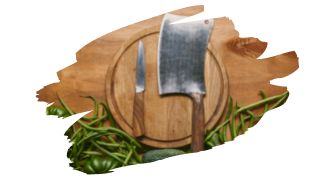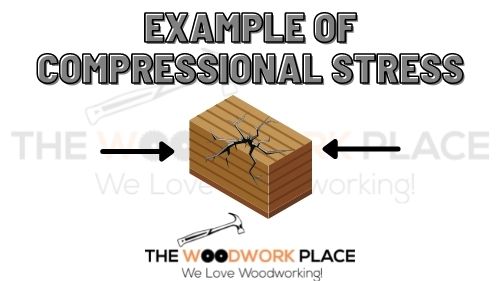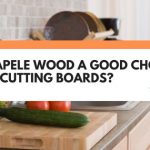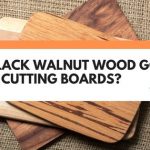It used to be that any leftover wood scrap was deemed good enough for making a cutting board project.
But, what if you plan on making a board that’ll be used for more than simply decoration. In that case, a poorly chosen wood can damage your expensive chopping cookware at best.
At worst, it could end up becoming a cross-contaminating food prepping surface.
So, what kind of wood makes for a safe food prepping surface? And is Rubber wood one of them?
Well, in this post, you will learn which three key criteria all cutting board material must meet. You will also learn why the compressional strength of wood matters, when it comes to cutting boards.
And keep reading to discover if Rubberwood truly makes for a great chopping block.

This post may contain affiliate links to products that we receive a commission for (at no additional cost to you). Learn more here.
What Is The Best Material For A Cutting Board?
Cutting board material needs to meet three key criteria;
- A). It must be easy to keep sanitary and clean.
- B). It must be hard enough to be able to absorb the impact of a chopping knife.
- C). But, it mustn’t be so hard that it ends up damaging your cookware.
Based on this, the top four best materials are wood, bamboo, plastic, and rubber (the material, not necessarily the wood).
Related Post: Can You Put Food Safe Epoxy Resin On Cutting Boards?
OK…But What Is The Best Kind Of Wood For A Cutting Board?
This is where things get a little bit interesting. Not all types of wood are equally suited for becoming a food prep surface.
You see, wood types that have large open pores, (such as Red Oak), are fairly hard to keep clean of food bits.
That’s because little morsels of food can get caught up in the pores of these types of wood. And once that happens, this can make it all too easy for harmful bacteria to grow on your cutting board.
Or worse, they can increase the risk of raw food cross-contamination.
Another thing you need to check for, when selecting cutting board lumber, is the wood’s toughness. A cutting board needs to be hard enough to take on chops, but not so tough that it wrecks your cookware.
Related Post: What Food Grade Wood Glue Is Safe Enough For Your Cutting Board?
And How Do You Work Out How Tough Wood Is?
One of the things we look for in cutting board wood, is where it lies along the Janka Hardness Scale. And we can do this by checking woods Janka rating.
The Janka rating measures the compressional strength of a piece of wood. The higher the Janka rating, the greater that wood’s strength. And the stronger the wood, the harder and more impact-resistant it is.
For example, one of the most popular types of cutting board wood is Hard Maple (also known as Sugar Maple). This North American hardwood has a Janka rating of 1450 lbf. So, that means it takes some 1450 pounds of force to make a dent in this timber.
What Is Compressional Strength? Compressional strength refers to how well a piece of wood can hold up against the compressional stresses put on it.

Right..So What About Rubber wood?
Rubber wood, (also known as Hevea), is much softer than Hard Maple.
You see, Rubber wood registers 960 lbf on the Janka scale. Which is a very good thing when it comes to cutting board material density.
And here’s why…optimal cutting board wood should fall within a certain Janka hardness range.
If that timber has a Janka rating of less than 900 lbf, it won’t last too long — and will splinter too easily. But, if it has a Janka rating of more than 1500 lbf, then your chopping utensils won’t last long either.
But, wood types that fall within this limited Janka rating range, make for great chopping block material. And Rubber wood falls neatly within this range.
And Is Rubberwood Water Resistant? I Mean, It’s Where Rubber Comes From, Right?
Rubber wood is very much a solid timber. Sure, rubber as a material is made from the latex liquid produced by this tree. However, the trees lumber itself is not used to make rubber, nor does it have a rubbery texture.
Still, while rubber is very water resistant, Rubber wood is not. Quite the opposite.
Rubber wood is not rot-resistant. And it will succumb to wood rot, if it doesn’t have a wood finish to protect it.
Related Post: What Is Rubberwood (And Does It Make Good Furniture?)
So, Does That Mean Rubberwood Is Not Suitable As A Cutting Board?
Rubber wood isn’t a great option for cutting board material, but not because of it’s lack of rot-resistance. Instead, it is because of the large open pores of this wood.
Rubber woods relatively large open pores increase the risk of cross contamination. Food bits and gristle can easily get snagged in them. And those pores also make it harder to thoroughly clean the surface of a cutting board made from this wood.
So, just as with Red Oak, this particular wood type doesn’t offer an ideal surface for food prepping.
Related Post: 4 Reasons Why You Should NOT Use Polyurethane On A Butcher Block
To Wrap Up, Here Are The 3 Key Takeaways From This Post…
- 1). While rubber comes from the latex produced by this tree, the tree’s lumber itself does not have the texture of rubber.
- 2). Rubber wood has just about the right density to make it an otherwise ideal cutting board.
- 3). However, the large open pores across the surface area of this lumber can increase the risk of cross-contamination. This is due to the chance of food bits getting snagged in those pores.



